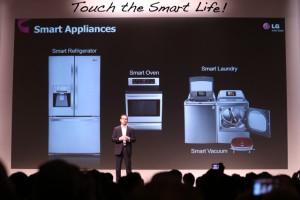The connected home
Ajit Deshpande - January 14, 2013 - 0 Comments
 The phrase ‘Internet of Things’ has been somewhat synonymous with the cutting-edge of technology for more than a decade now; every major technological advancement, whether in computing, connectivity or mobility, has resulted in applications that have led to a more connected world. Last week’s CES show helped move the ball further down the field, with LG announcing its latest line of smart appliances that can be controlled through NFC enabled smartphones. These new appliances (such as refrigerators, washers, dryers and ovens) can be paired with smartphones using NFC tags, after which point LG’s voice-enabled smartphone app can communicate with them over WiFi/3G/4G. The appliances themselves can analyze data and share insights, for example, a refrigerator keeping track of its contents and communicating potential expiry dates, possible recipes etc.
The phrase ‘Internet of Things’ has been somewhat synonymous with the cutting-edge of technology for more than a decade now; every major technological advancement, whether in computing, connectivity or mobility, has resulted in applications that have led to a more connected world. Last week’s CES show helped move the ball further down the field, with LG announcing its latest line of smart appliances that can be controlled through NFC enabled smartphones. These new appliances (such as refrigerators, washers, dryers and ovens) can be paired with smartphones using NFC tags, after which point LG’s voice-enabled smartphone app can communicate with them over WiFi/3G/4G. The appliances themselves can analyze data and share insights, for example, a refrigerator keeping track of its contents and communicating potential expiry dates, possible recipes etc.
We have come a long way in this journey towards a connected home – motion sensors, smart meters, networked lighting, connected security devices, smartphones, smart TVs, and now smart appliances. More so, there has also been increasing demand in recent times for remote access and cloud-based control for devices as garage door openers, irrigation controllers, power switches etc. – single-function devices that can still benefit from remote connectivity – and companies including Opus portfolio company Arrayent have been offering cost-efficient, appliance-agnostic ways for instrumenting and cloud-enabling such devices.
So what can we expect next? As corporations like Samsung, LG and GE introduce smart appliances, what will it take to be able to communicate and control appliances across these diverse brands? A smartphone could be a logical control node in the connected home, but most smartphone makers also make appliances, resulting in potential conflicts of interest from data-sharing. And what if a smaller player, say a sprinkler system manufacturer wanted to offer connected devices but didn’t have the expertise for it? Clearly there is need for device-agnostic, platform players in getting us to a truly connected home. Cisco & AT&T could be an option, and so could be someone like Arrayent in partnership with individual device manufacturers. Access to household data is the big prize that a connected home will bring, accompanied by a multitude of monetization opportunities, and so we will for sure see evolution at a rapid pace. The infrastructure is coming together; now on to a connected, smart home, all at the fingertips of the consumer!